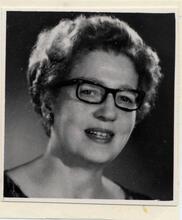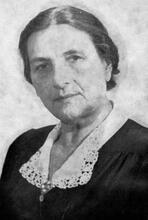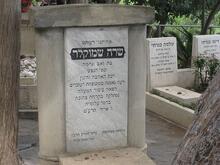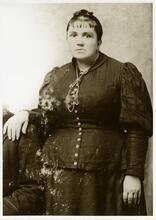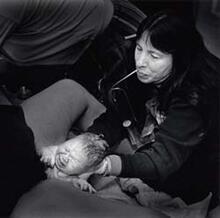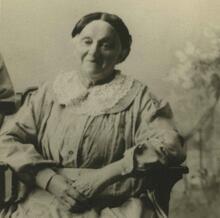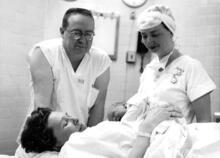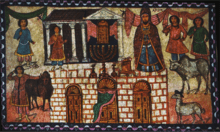Doctors: Medieval
Many Jewish women practiced medicine throughout Europe and the Middle East during the medieval period. Among the women doctors, healers, and midwives, doctors are the easiest to find, but the distinction between doctors and healers in medieval women’s medical practice was very blurred. To become practitioners, Jewish women learned through apprenticeship to other doctors, often members of their own families, since no Jews were allowed in medical schools. While some areas in which Jews lived had no Jewish women doctors, in others up to ten percent of the Jewish doctors were women. These women formed an integral part of the Jewish working community.
Introduction
When I was an infant about three months old, my eyes were affected and were never completely restored. A certain woman tried to cure me when I was about three years of age but she added to my blindness to such an extent that I remained confined to the house for a year, being unable to see the road on which to walk. Then a Jewess, a skilled oculist, appeared on the scene. She treated me for about two months and then died. Had she lived another month, I might have recovered my sight fully. As it was, but for the two months’ attention from her, I might never have been able to see at all.
With these words, found in the collection of ethical wills edited by Israel Abrahams, R. Yehudah ben Asher introduces us to the woman oculist in thirteenth century Cologne who preserved his sight. This unnamed woman was just one of the many Jewish women who practiced medicine throughout Europe and the Middle East during the Middle Ages.
In the medieval period, Jewish women doctors were found in most of the countries of western and central Europe, i.e., Spain, France, Provence, Italy, Sicily, and especially in Germany. Slawa of Warsaw (1435) is the only one who has so far been found from eastern Europe, but others will probably come to light when the records are examined more thoroughly. Evidence of women doctors in Egypt and Turkey comes from the beginning (ninth to twelfth centuries) of this period and from its end (sixteenth and seventeenth centuries), although evidence for women healers is scattered throughout the sources.
Sources of information on European Jewish women doctors are found mainly in non-Jewish records. These include notarial registers, town council decisions, taxation rulings, court records, licensing agreements and other similar documents. However, several are found in Jewish sources, in an ethical will, in a Halakhic decisions written by rabbinic authories in response to questions posed to them.responsum, and in the book of a circumciser.
According to Monica Green, the definition of female medical practitioners is, “Women who at some point in their lives would have either identified themselves in terms of their medical practice or been so identified by their communities.” This definition includes three kinds of medieval women medical practitioners: doctors, midwives, and healers. Among these categories doctors are the easiest to find because their activities are the most documented, but the distinction between doctors and healers in medieval women’s medical practice is very blurred. In jurisdictions in which physicians were licensed, it could be supposed that those that had licenses were doctors while the unlicensed were healers. A few Jewish women doctors were licensed, for example Na Bellaire and Na Pla, two medical women of Lérida, Aragon (1387). But women without licenses could also be doctors, rather than healers. This can be discerned by the terms used to identify them. The distinction between doctor and healer is probably related to the amount of authority the woman possessed, the economic status of the population she served, the power of the medical establishment of her area, and whether the population she served was urban or rural.
During the medieval era the practice of medicine was rarely a full-time occupation. Medieval women (like medieval Jews in general) had weak work identities. In the case of medieval women doctors, their medical work was often sporadic and fitted in with their other work. For instance, as Green states, “Mayrona of Manosque, Provence, Fisica, is never documented in the act of healing. A doctor, and acknowledged as such by her community, she appears in most of the forty-five documents known to mention her in her other occupation of money-lender.”
Since they were not allowed into the medical schools, Jewish doctors, both male and female, learned through apprenticeship to other doctors, often members of their own families. This could lead to family groupings of doctors. Both Benedictus, the father of Mayrona of Manosque (1343), Fisica, and possibly her husband, Leo Frances, were physicians. The surgica, Fava, of Manosque, Provence (1321) who will be mentioned again later was the daughter of Astrugus, a surgeon. She had a son and two grandsons who were also surgeons. There is also a possible mother-daughter pair. Sarre, la mirgesse (the doctor), is listed in the Paris tallage of 1292. According to Melanie Lipinska, a historian of women doctors, Sarre’s daughter Florion also practiced medicine.
Though one might think that these women only treated other women, in most cases only other Jewish women, the evidence shows the opposite. They treated Christian women and men and Jewish women and men. One very interesting case in which a Jewish woman doctor treated a Christian man concerned Fava of Manosque. As Shatzmiller states:
The records from Manosque at the end of 1321 and the beginning of 1322 give information about the female surgeon Hava (or Hana) who intervened to rescue a wounded Christian gentleman by the name of Poncius Porcelli. He had been hit in the most intimate organs of his body and the court wanted to know whether Hava had actually palpated the wound. Luckily, she could answer in the negative because her son Bonafos had assisted her during the treatment. She merely gave the instructions and assigned the necessary medicines, while her son did the actual handling.
Germany
There is a great deal of evidence for Jewish women doctors in medieval Germany. There, and in several other places, the treatment of the eyes was their specialty. In addition to the oculist of R. Yehudah ben Asher, we also know about Marat Yuskah of early thirteenth century Mainz or Worms. An article by Elisheva Baumgarten offers the following quote:
A choice and good powder for the eyes which sterilizes around the eye and also is recommended for red eye by Marat Yuskah, a wise woman, for brightening the light of the eyes. Take calamine that is similar to a white stone of a weight of half a zekuk and take from it five or six pieces and burn them. Remove it with tongs and put it into a jar of strong vinegar. Do it nine times to soften the calamine. Afterwards pound the calamine in a mortar well until it is a fine powder and sift the powder through a thin cloth. Every night take a palm’s worth and dilute it with a bit of wine or saliva and put it around the eye when you go to sleep. And it will brighten the eyes. This is a tested and proven remedy (Translation by Cheryl Tallan).
A list of women doctors in Frankfurt-am-Main (1389–1497) includes Serlin (1428), who was allowed to live outside the Jewish quarter among the Christian citizens. She requested that the municipal authorities absolve her from the tax burden on the basis of her competence and popularity. Her request, however, was rejected by the council. Serlin may be the same Jewish woman eye doctor listed in a record of 1431 who was forbidden to lend money on interest because it was assumed that she earned income through her practice of medicine. Still another possibility, however, is that the doctor mentioned in the 1431 entry was Gnenlin (Frankfurt-am-Main, 1431–1439 or 1457).
Another prominent Jewish woman doctor in Germany was Sara of Würtzburg, who on May 2, 1419, received permission from Bishop Johann II of Brunn to practice medicine throughout the diocese. She paid two florins for the permission and ten florins for taxes and a contribution. In a separate transaction twenty days later, Sara received a document signed by the entire court giving her possession of the lands of Friederich von Riedern (Friedenwald, 218–219).
Several other Jewish women doctors—Josgemin of Freiburg im Breisgau, Sarah of Lauda am Tauber, Genevlin of Esslingen am Neckar, Göldchen v. Nürnburg of Mainz, unnamed women doctors in Gunzenhausen and Nordlingen and Wallerstein—are mentioned in Germania Judaica, Band III, under their various places of origin.
France and Provence
Jewish women doctors also practiced in medieval France and Provence. Among the earliest names found in the sources are Sarre of Paris (1292) and her daughter Florion, Hava (1321–1322), and Mayrona (1342) of Manosque, Provence. Sara de Sancto Aegidio (Saint Gilles), widow of the physician Abraham, is the only woman definitely known to have taught medicine in the Middle Ages. An agreement to this effect was found in the records of Marseilles, dated August 28, 1326. It states that Sara and her disciple Salvetus de Burgonoro, an inhabitant of Salon in Provence, agree as follows: “Sara agreed to teach Salvet artem medicine et phisice for the period of seven months; and she further agreed to board, lodge, and clothe Salvet. In return the pupil was to relinquish all fees which he might receive during his apprenticeship and turn them over to his instructress.” Sara’s teaching function was emphasized by the declaration that, in addition to providing Salvet with food and clothing, she was “to teach him a praiseworthy trade.”
Spain
In medieval Spain some of the Jewish women doctors were licensed. Astruga of Barcelona (1342), who practiced surgery only on Jewish patients, did not have to go through an examination prior to her licensing. Na Bellaire and Na Pla, two medical women of Lérida, Aragon, received their licenses from Pedro IV of Aragon and had them confirmed in 1387.
Some of the Jewish women doctors cared for royalty. Na Floreta Çanoga, from Santa Caloma de Queralt, attended Queen Sibila of Aragon in 1381. In Valencia in the second half of the fourteenth century, Na Ceti and Bonanada, a midwife, probably Jewish, treated the wife of the Crown Prince, Don Juan, and provided services to the royal family.
Italy
The earliest of the Italian Jewish women doctors about whom we have information is Monna Antonia di maestro Daniele (ebrea medicha) of Florence, who matriculated as a doctor in The Guild of Doctors, Apothecaries, and Grocers between 1386 and 1408. In Rome, Manuela and her son Angelo were personal physicians to Pope Bonifacius IX. They had such a good reputation that in 1399 they were exempted from their tax burden. Manuela and Angelo were said to be helpful, benevolent, and zealous in helping the poor and the wretched. They did not press for payment and were extraordinarily experienced in their profession.
Another Jewish woman doctor, mentioned in a Jewish source, is found in a question sent to R. Azriel Diena (d. 1536) concerning a quarrel over an inheritance. The rabbi was consulted in the dispute between the orphaned children of Reuben and their uncle Simon. The orphans were claiming assets of the estate of their grandfather, Jacob. The question to R. Diena stated: “The sons of Reuben claim that in the house of their grandfather, Jacob, there were always found certain assets through which Simon their uncle earned [money]. And, in addition to that, their grandmother, Jacob’s wife, earns more through [her] medical practice than Simon, her son.”
Sicily
In Sicily, Virdimura, the wife of Pasquale, the physician of Catania, was examined in 1376 by the physicians of the Royal Court and obtained permission to practice medicine throughout the kingdom. She said that she wanted to devote herself to the treatment of the poor who found it difficult to pay the enormous fees of other physicians.
Eastern Europe
Slawa of Warsaw is the only medieval Jewish woman medical practitioner we have found in eastern Europe. In 1435 her husband Alexander contracted an agreement with one Maciej Suszka in which she undertook to cure the illness to which the wife of Suszka had succumbed. If the medicine worked, Slawa would obtain a reward of three kopeks groszy. If not, Suszka would be exempt from paying the “honorarium.”
Mediterranean Area
Among the earliest Jewish women doctors found in the sources were those of medieval Egypt. A woman eye doctor, kahh?la, is mentioned in the Place for storing books or ritual objects which have become unusable.Genizah documents (ninth to thirteenth centuries). This specialty may have continued throughout the period all around the Mediterranean area, since we find Jewish women eye doctors in sixteenth-century Jerusalem. Amnon Cohen posits that they may originally have been cosmeticians who used antimony, kuhl, in the preparation of cosmetics for the eyes. Thus they might have become experienced in dealing with eye problems.
In the next century, in Turkey, and dealing with a different social class, Bula Ikschati, the widow of the renowned statesman and doctor Salomon Ashkenasi, cured the young Sultan Achmed I of smallpox in 1603.
Conclusion
Many people assume that Jewish women began to enter the professions at the beginning of the twentieth century. But research has revealed Jewish women who were active as doctors and worked in other forms of the healing professions throughout the Middle Ages. In most cases, they had the same type of training and treated the same kind of patients as male Jewish doctors. While some areas in which Jews lived in the medieval period had no Jewish women doctors, in other areas up to ten percent of the Jewish doctors were women. These women practicing medicine were not exceptional cases; they did not simply make inroads into a domain usually reserved for men. Rather, they formed an integral part of the Jewish working community in their places of residence and deserve to be included in the listing of Jewish professionals of the medieval era.
Ashkenazi, Shlomo. “Famous Jewish women doctors (Hebrew).” Mahanyyim 123 (1969–1970): 146–157.
Baumgarten, Elisheva. “Thus Spoke the Wise Midwives: Midwives and Midwifery in Thirteenth Century Ashkenaz (Hebrew).” Zion 65 (2000): 45–74.
Cardoner Planas, A. “Seis mujeres hebreas practicando la medicina en el reino de Aragon.” Sefarad 9 (1949): 441–445.
Cohen, Amnon. Jewish Life under Islam: Jerusalem in the Sixteenth Century. Cambridge: 1984.
Diena, Azriel. She’elot u-Teshuvot R. Azriel ben R. Shlomo Diena. Ed. Yakov Boksenboim, vol. 2. Tel Aviv: 1977, 240.
Friedenwald, Harry. “Jewish Doctoresses in the Middle Ages.” In Harry Friedenwald. The Jews and Medicine. 2 vols. Rpt. New York: 1967. 1: 217–220.
Germania Judaica, Band III (1350–1519). Ed. Arye Maimon, Mordechai Breuer, and Yakov Guggenheim. 2 Teilbände. Tubingen: 1987–1995.
Goitein, S[helomo] D. A Mediterranean Society: the Jewish Communities of the Arab World as Portrayed in the Documents of the Cairo Geniza. 6 vols. Berkeley: 1967–1993. 1:127–128.
Green, Monica H. “Documenting medieval women’s medical practice.” In Practical Medicine from Salerno to the Black Death. edited by Luis García-Ballester, Roger French, Jon Arrizabalaga and Andrew Cunningham, 322–352. Cambridge: 1994.
Kriegk, Georg L. Deutsches Bürgerthum im Mittelalter: Nach urkundlichen Forschungen und mit besonderer Beziehung auf Frankfurt am Main. Rprt. Frankfurt a. M.: 1969.

